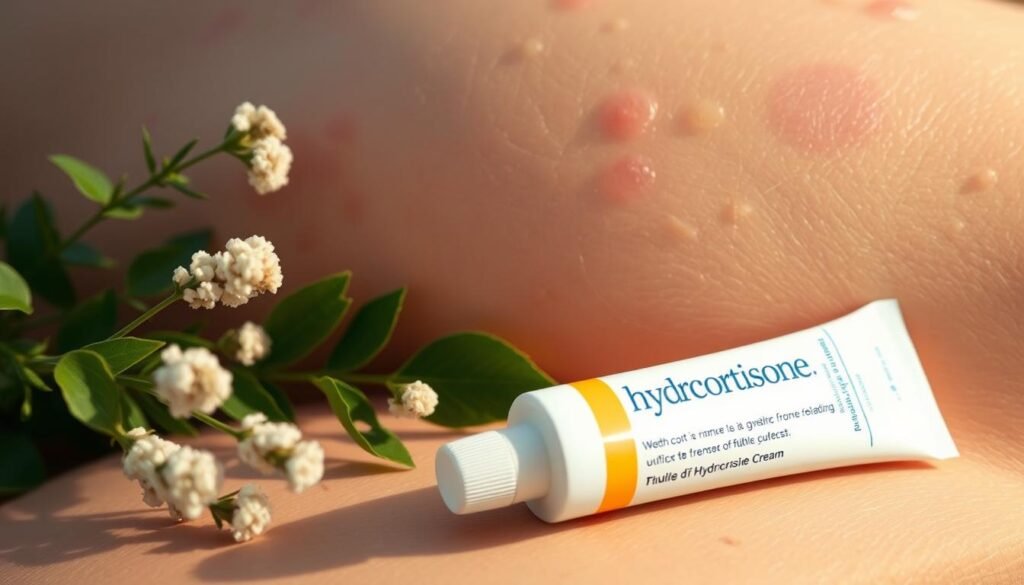Did you know about 30% of folks get folliculitis at some point? This skin issue inflames hair follicles causing discomfort. But, there’s good news. Plenty of OTC options can soothe and heal your skin. Knowing what’s out there helps you take charge of your symptoms. For tough cases, you’ll still want a doctor’s input. Yet, many effective solutions don’t even need a prescription.
Key Takeaways
- Folliculitis is common and affects a significant percentage of people.
- Effective OTC treatments can alleviate symptoms and promote healing.
- Many treatments for folliculitis do not require a prescription.
- Identifying the right treatment option is crucial for effective management.
- Professional advice is recommended for severe or persistent cases.
Understanding Folliculitis
Folliculitis is a widespread skin condition. It results from inflamed hair follicles. Often, this inflammation is due to an hair follicle infection from bacteria or fungi, or just irritation. People may see signs like:
- Red bumps around hair follicles
- Pus-filled blisters
- Itching or discomfort in the affected spot
To treat it well, knowing the main characteristics is key. The signs can show up on any body part with hair follicles. Things like bad hygiene, tight clothes, or some medical treatments can cause it. By recognizing these signs early, people can get help fast and control this common issue.
What Causes Folliculitis?
It’s important to know what causes folliculitis to treat it right. A big cause is bacterial infections, especially from Staphylococcus aureus. This germ causes inflammation and redness around hair follicles, leading to discomfort.
Fungal infections are also to blame. Issues like those from Malassezia yeast can inflame hair follicles, especially in hot, damp places. Keeping your skin clean is key to stopping these infections.
Irritation from things like tight clothes or harsh soaps can also cause problems. If you have skin issues like eczema or acne, you might be more likely to get folliculitis. It’s all about avoiding what irritates your skin.
Knowing the different causes helps you treat folliculitis better. Being aware and careful can make a big difference in handling this skin issue.
| Cause | Details | Prevention Tips |
|---|---|---|
| Bacterial Infections | Mainly Staphylococcus aureus | Maintain skin hygiene, avoid using contaminated items |
| Fungal Infections | Caused by Malassezia yeast | Keep the skin cool and dry, use antifungal treatments if needed |
| Irritation | Resulting from tight clothing or shaving | Choose breathable fabrics, use a clean razor, avoid irritation-inducing products |
Over-the-Counter Treatments for Folliculitis
Folliculitis has many seeking relief through over-the-counter (OTC) options. You can find treatments like topical antibiotics and antifungal creams. These are key to a successful care routine.
Topical Antibiotics
Topical antibiotics are crucial for bacterial folliculitis. Using products like Neosporin and Bacitracin can lower bacteria levels. This speeds up healing. Effective topical solutions are simple to use. Just follow the directions for the best results. The right application makes them work faster.
Antifungal Creams
Fungal folliculitis needs antifungal creams. Options include Clotrimazole and Miconazole that fight yeast and fungi. This eases symptoms. OTC folliculitis treatments help ease pain. They tackle the root of the infection. Know the possible side effects to get the most from these treatments.
| Treatment Type | Example Products | Target Condition | Application Frequency |
|---|---|---|---|
| Topical Antibiotics | Neosporin, Bacitracin | Bacterial Folliculitis | 2-3 times daily |
| Antifungal Creams | Clotrimazole, Miconazole | Fungal Folliculitis | 1-2 times daily |
Knowing your options is empowering when dealing with folliculitis. With accurate info and treatments, finding relief is possible.
The Role of Benzoyl Peroxide
Benzoyl peroxide is a famous acne treatment. It is known for its antibacterial properties. It not only fights acne but also helps with folliculitis. This is when bacteria inflame hair follicles.
One great thing about benzoyl peroxide is its fight against Cutibacterium acnes bacteria. This bacteria can cause skin problems. Benzoyl peroxide puts oxygen into the follicles. This stops bacteria from growing.
It’s important to use benzoyl peroxide right to get the best results. Start with a small amount once a day. You can use more as your skin gets used to it. This helps keep your skin from getting too dry.
Adding benzoyl peroxide to your skin care can help if you often get folliculitis. For detailed advice on treating skin issues, check out medical literature. This has more info on how to use it well.
Using Salicylic Acid for Folliculitis
People with folliculitis often search for effective ways to ease their symptoms and avoid future outbreaks. Salicylic acid is widely used for its benefits, especially known for its exfoliating properties. It helps in clearing out hair follicles, leading to healthier skin. This is especially helpful for those with folliculitis, as blocked pores can cause inflammation and discomfort.
Benefits of Salicylic Acid
Salicylic acid brings many benefits to those suffering from folliculitis:
- Exfoliation: It removes dead skin, allowing fresh skin to emerge.
- Reduces Inflammation: Its anti-inflammatory nature soothes the skin, minimizing redness and swelling.
- Prevents Future Breakouts: By keeping the follicles clear, it helps in preventing further cases of folliculitis.
- Versatile Applications: With its availability in various forms like cleansers, lotions, and spot treatments, it’s easy to add to your skincare routine.
Using salicylic acid for folliculitis focuses on immediate symptom relief and maintaining long-term skin health. Choosing the right salicylic acid product helps individuals customize their treatment for their skin type and specific needs.
| Product Type | Description | Notes |
|---|---|---|
| Cleansers | Foaming or gel-based cleansers that incorporate salicylic acid. | Great for daily use to keep pores clear. |
| Lotions | Moisturizers infused with salicylic acid, providing hydration. | Helps in softening and treating skin conditions. |
| Spot Treatments | Targeted applications for specific inflamed areas. | Quick relief for immediate concerns. |
Natural Remedies and Tea Tree Oil
Exploring natural remedies for folliculitis can offer new ways to treat it. Tea tree oil is notable for its antifungal properties. It helps reduce inflammation. This oil comes from the Melaleuca alternifolia plant’s leaves. It has powerful antimicrobial traits that help fight the bacteria leading to folliculitis. This makes the skin healthier.

Using tea tree oil is straightforward, but caution is necessary. It’s important to dilute it correctly. Mix a few drops with a carrier oil, like coconut or jojoba oil. This makes it safe and effective. Usually, mix one part tea tree oil with eight parts carrier oil. This method lessens skin irritation risks while boosting benefits.
Aside from tea tree oil, other essential oils can also help. Aloe vera is known for moisturizing and healing skin. It works well with tea tree oil for skin care, adding more relief and moisture.
Using a mix of natural remedies for folliculitis can lead to better results. Adding these treatments to your daily routine is wise. Consistent use is key to seeing improvement. Notice how your skin reacts and adjust the use as needed.
Benefits of Warm Compresses
Warm compresses are a handy home remedy for treating folliculitis at home. Applying heat helps greatly by reducing inflammation and letting pus-filled bumps drain. This technique eases discomfort and clears up the skin.
- Take a clean cloth and soak it in warm water.
- Wring out any excess water.
- Press the cloth gently against the affected area for 10-15 minutes.
Using warm compresses often can help calm skin irritation. Repeat several times daily for the best outcome. These steps show the big benefits of warm compresses in home care.
Adding warm compresses can really help your care plan if you have folliculitis. For more tips on home care, check out: treating folliculitis at home.
Hydrocortisone Cream: Is It Effective?
Hydrocortisone cream is well-known for reducing skin irritation. It is often used for conditions like folliculitis. It diminishes redness and itchiness, offering needed relief. The soothing skin benefits make it a go-to for easing discomfort.
This cream is an over-the-counter solution and is easy to get for mild symptoms. It is recommended for use over a short period. This helps limit side effects and aids in healing the skin properly.
However, using this cream too much can be harmful. It may cause the skin to thin or lead to other bad reactions. If symptoms don’t improve or get worse, seeing a doctor is crucial. They may prescribe a stronger medication for tougher cases.
| Aspect | Hydrocortisone Cream | Stronger Prescription Options |
|---|---|---|
| Type | Over-the-counter | Prescription |
| Hydrocortisone Content | Low concentration | Higher concentration |
| Usage Duration | Short-term | As directed by a doctor |
| Common Side Effects | Minimal | Varies based on medication |
| Effectiveness for Mild Symptoms | High | Variable based on condition |

Choosing Gentle Cleansers
When dealing with folliculitis, it’s smart to use gentle cleansers for folliculitis. Finding the right kind of soap is key to keep your skin healthy. Regular soaps might remove too much oil from your skin. This can make your skin dry and worsen inflammation.
Look for options that are non-comedogenic and free from fragrances. They should protect your skin. Cetaphil Gentle Skin Cleanser and Neutrogena Ultra Gentle Hydrating Cleanser are top picks. They cleanse well without drying out or irritating your skin. This makes them match well with what your skin needs.
Using the right cleanser can help lessen folliculitis flare-ups. Keep these points in mind when picking a product:
| Brand | Type | Key Features |
|---|---|---|
| Cetaphil | Gentle Skin Cleanser | Fragrance-free, non-comedogenic |
| Neutrogena | Ultra Gentle Cleanser | Mild surfactants, hydrating |
| La Roche-Posay | Toleriane Hydrating Gentle Cleanser | Soothing, non-irritating ingredients |
Having a skincare routine that avoids irritation is vital. Always test new products on a small skin area first. Gradually include them in your skincare routine. This helps check for any skin reactions. Doing so will help your skin stay more comfortable and healthier.
For extra info on folliculitis and how to manage it, check out WebMD. You’ll find all you need to know about it there.
Importance of Hygienic Practices
Keeping up with personal hygiene is key to prevent folliculitis and ensure your skin stays healthy. Doing simple things every day can lower your chances of getting this skin issue. For instance, regular exfoliation takes away dead skin that can block hair follicles, leading to better skin health.
Also, not sharing personal items like razors, towels, and clothes helps stop bacteria from spreading. These bacteria are often behind folliculitis. It’s important to keep everything clean, including your laundry. Washing towels and clothes often prevents bacteria from lingering and moving onto your skin.
Creating skin care routines that focus on staying clean not only cuts down on folliculitis risks. It also helps your skin stay strong and healthy over the years. Talking to health experts about the right hygiene methods can help too. Plus, being careful with vitamins like biotin is smart. You can learn about their risks, like those listed here.
| Hygienic Practice | Description | Benefits |
|---|---|---|
| Regular Exfoliation | Gently removes dead skin cells | Prevents clogged follicles |
| Avoiding Shared Items | Prevents bacterial transfer | Reduces risk of infection |
| Frequent Washing | Regularly washing clothes and towels | Minimizes bacterial growth |
| Daily Skin Care Routine | Consistent use of suitable products | Enhances overall skin health |

Potential Risks and Side Effects
Using over-the-counter (OTC) treatments for folliculitis might look simple. But, it’s key to know the risks these treatments carry. They can cause side effects of folliculitis remedies like skin irritation, allergic reactions, and more.
OTC meds, including topical antibiotics or antifungal creams, could have downside effects. Overusing them or reacting to their ingredients can irritate the skin. It’s a good plan to do a patch test before using them all over.
Long-term use of some treatments raises concerns too. Using these meds too much might break the skin’s natural defenses. That makes the skin more likely to get infections or flare-ups. If symptoms don’t get better or if they worsen, talking to a doctor is crucial. They can help you weigh the risks and choose the right treatment for your skin. For more advice, check out understanding the treatment options.
Conclusion
In wrapping up, the article showed many good over-the-counter (OTC) treatments for folliculitis. These include creams with antibiotics or antifungals. Also, ingredients like benzoyl peroxide and salicylic acid can help ease the symptoms.
Keeping your skin healthy is very important. This means washing well and using kind cleansers. Doing this regularly can manage and even stop future skin problems. If your skin issues don’t go away, you should see a skin doctor for special advice.
Knowing what treatments are out there gives people the power to improve their skin health. By trying different treatments and caring for your skin properly, you can fight the irritation of folliculitis. And, you can have healthier skin.
